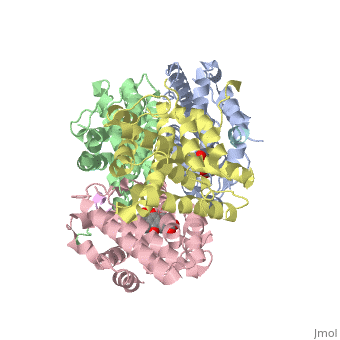Nuclear receptor corepressor
FunctionNuclear receptor corepressors (N-CoR) and SMRT (Silencing Mediator of Retinoic acid and Thyroid hormone receptor) mediate the repression of gene subscription by nuclear receptors[1]. N-CoRs contain interaction domains with a conserved LXXII hydrophobic motif. This motif resembles the LXXLL motif of nuclear receptors[2].
RelevanceN-CoR1 may play an important role in human cancers[4]. SMRT has a role in mitochondrial oxidative metabolism and the aging process[5]. Structural highlightsThe LXXII motif of the SMRT corepressor binds to the ligand binding domain of the retinoid acid repressor. The antagonist ligand Rhein binds to cysteine residue in the hydrophobic pocket of the repressor[6]. |
| ||||||||||
3D Structures of nuclear receptor corepressor3D Structures of nuclear receptor corepressor
Updated on 17-July-2024
ReferencesReferences
- ↑ Xu HE, Stanley TB, Montana VG, Lambert MH, Shearer BG, Cobb JE, McKee DD, Galardi CM, Plunket KD, Nolte RT, Parks DJ, Moore JT, Kliewer SA, Willson TM, Stimmel JB. Structural basis for antagonist-mediated recruitment of nuclear co-repressors by PPARalpha. Nature. 2002 Feb 14;415(6873):813-7. PMID:11845213 doi:10.1038/415813a
- ↑ Webb P, Anderson CM, Valentine C, Nguyen P, Marimuthu A, West BL, Baxter JD, Kushner PJ. The nuclear receptor corepressor (N-CoR) contains three isoleucine motifs (I/LXXII) that serve as receptor interaction domains (IDs). Mol Endocrinol. 2000 Dec;14(12):1976-85. doi: 10.1210/mend.14.12.0566. PMID:11117528 doi:http://dx.doi.org/10.1210/mend.14.12.0566
- ↑ Li C, Sun XN, Chen BY, Zeng MR, Du LJ, Liu T, Gu HH, Liu Y, Li YL, Zhou LJ, Zheng XJ, Zhang YY, Zhang WC, Liu Y, Shi C, Shao S, Shi XR, Yi Y, Liu X, Wang J, Auwerx J, Wang ZV, Jia F, Li RG, Duan SZ. Nuclear receptor corepressor 1 represses cardiac hypertrophy. EMBO Mol Med. 2019 Nov 7;11(11):e9127. PMID:31532577 doi:10.15252/emmm.201809127
- ↑ Fozzatti L, Park JW, Zhao L, Willingham MC, Cheng SY. Oncogenic Actions of the Nuclear Receptor Corepressor (NCOR1) in a Mouse Model of Thyroid Cancer. PLoS One. 2013 Jun 26;8(6):e67954. doi: 10.1371/journal.pone.0067954. Print 2013. PMID:23840792 doi:http://dx.doi.org/10.1371/journal.pone.0067954
- ↑ Reilly SM, Bhargava P, Liu S, Gangl MR, Gorgun C, Nofsinger RR, Evans RM, Qi L, Hu FB, Lee CH. Nuclear receptor corepressor SMRT regulates mitochondrial oxidative metabolism and mediates aging-related metabolic deterioration. Cell Metab. 2010 Dec 1;12(6):643-53. doi: 10.1016/j.cmet.2010.11.007. PMID:21109196 doi:http://dx.doi.org/10.1016/j.cmet.2010.11.007
- ↑ Zhang H, Chen L, Chen J, Jiang H, Shen X. Structural basis for retinoic X receptor repression on the tetramer. J Biol Chem. 2011 May 24. PMID:21613212 doi:10.1074/jbc.M111.245498
